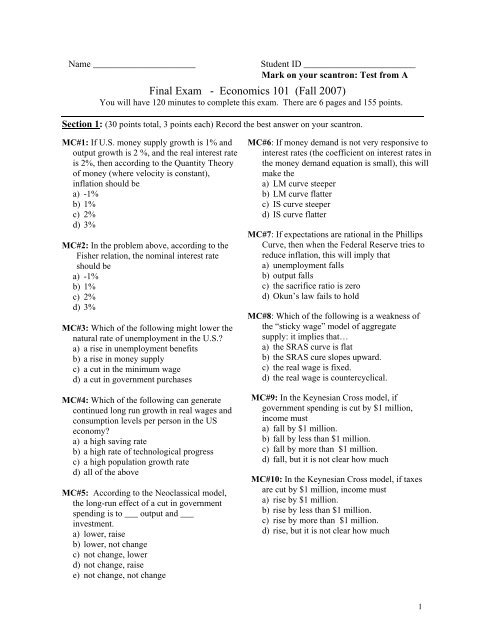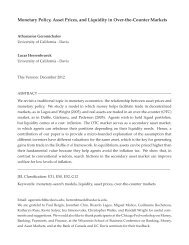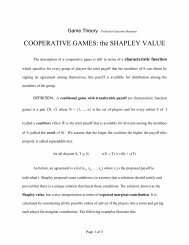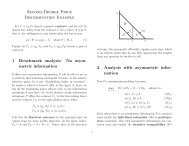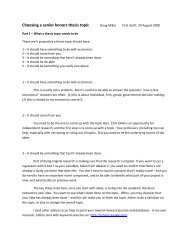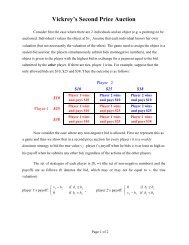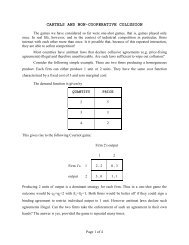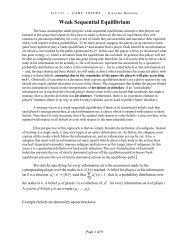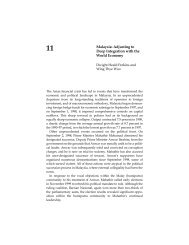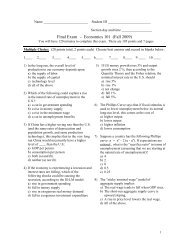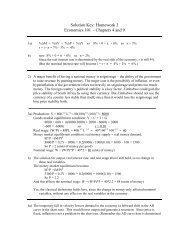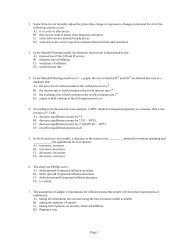Final Exam - Economics 101 (Fall 2007)
Final Exam - Economics 101 (Fall 2007)
Final Exam - Economics 101 (Fall 2007)
- No tags were found...
Create successful ePaper yourself
Turn your PDF publications into a flip-book with our unique Google optimized e-Paper software.
Name ______________________Student ID ________________________Mark on your scantron: Test from A<strong>Final</strong> <strong>Exam</strong> - <strong>Economics</strong> <strong>101</strong> (<strong>Fall</strong> <strong>2007</strong>)You will have 120 minutes to complete this exam. There are 6 pages and 155 points.Section 1: (30 points total, 3 points each) Record the best answer on your scantron.MC#1: If U.S. money supply growth is 1% andoutput growth is 2 %, and the real interest rateis 2%, then according to the Quantity Theoryof money (where velocity is constant),inflation should bea) -1%b) 1%c) 2%d) 3%MC#2: In the problem above, according to theFisher relation, the nominal interest rateshould bea) -1%b) 1%c) 2%d) 3%MC#3: Which of the following might lower thenatural rate of unemployment in the U.S.?a) a rise in unemployment benefitsb) a rise in money supplyc) a cut in the minimum waged) a cut in government purchasesMC#4: Which of the following can generatecontinued long run growth in real wages andconsumption levels per person in the USeconomy?a) a high saving rateb) a high rate of technological progressc) a high population growth rated) all of the aboveMC#5: According to the Neoclassical model,the long-run effect of a cut in governmentspending is to ___ output and ___investment.a) lower, raiseb) lower, not changec) not change, lowerd) not change, raisee) not change, not changeMC#6: If money demand is not very responsive tointerest rates (the coefficient on interest rates inthe money demand equation is small), this willmake thea) LM curve steeperb) LM curve flatterc) IS curve steeperd) IS curve flatterMC#7: If expectations are rational in the PhillipsCurve, then when the Federal Reserve tries toreduce inflation, this will imply thata) unemployment fallsb) output fallsc) the sacrifice ratio is zerod) Okun’s law fails to holdMC#8: Which of the following is a weakness ofthe “sticky wage” model of aggregatesupply: it implies that…a) the SRAS curve is flatb) the SRAS cure slopes upward.c) the real wage is fixed.d) the real wage is countercyclical.MC#9: In the Keynesian Cross model, ifgovernment spending is cut by $1 million,income musta) fall by $1 million.b) fall by less than $1 million.c) fall by more than $1 million.d) fall, but it is not clear how muchMC#10: In the Keynesian Cross model, if taxesare cut by $1 million, income musta) rise by $1 million.b) rise by less than $1 million.c) rise by more than $1 million.d) rise, but it is not clear how much1
Problem 1: Neoclassical Model (30 points total)Suppose the real side of the U.S. macroeconomy is characterized as follows:Production: Y = 10 K 1/2 L 1/2Factor supply: K = 100 L = 100Government: G = 200 T = 200Consumer behavior: C = 100 + 0.5(Y-T)Investment behavior: I = 400 - 1000rSuppose the nominal side of the economy is characterized by the following:Quantity theory of money: MV = PY where V=5Nominal money supply: M = 400(Y is real GDP, K capital, L labor, G government purchases, T taxes, C consumption, I investment,r real interest rate, P price level, M money supply, V velocity.)a) (10 points) Compute the equilibrium levels of the following five variables:real interest rate, real GDP, real wage, price level, nominal wageShow your work, and be careful about mathematical accuracy. In a sentence or two, explain theequilibrium condition you used for the goods market, and the economic reasoning why the realinterest rate must take the value you computed above.b) (6 points, mark on scantron) Suppose that the government decreases the money supply. Whateffect will this have on the variables listed below? Mark the answer on your scantron. Nocomputations necessary; no explanation required.MC#11) Price level (a) rise (b) fall (c) no change (d) insufficient informationMC#12) Real GDP (a) rise (b) fall (c) no change (d) insufficient informationMC#13) Nominal wage (a) rise (b) fall (c) no change (d) insufficient information2
c) (10 points, scantron) Assume money supply is back at the original level. Suppose now thatimmigration raises the labor force. What effect will this rise in labor force have on thevariables listed below? Mark the answer on your scantron. No computations necessary; noexplanation required.MC#14) Real GDP (a) rise (b) fall (c) no change (d) insufficient informationMC#15) real interest rate (a) rise (b) fall (c) no change (d) insufficient informationMC#16) real wage (a) rise (b) fall (c) no change (d) insufficient informationMC#17) price level (a) rise (b) fall (c) no change (d) insufficient informationMC#18) nominal wage (a) rise (b) fall (c) no change (d) insufficient informationd) (4 points) Explain in a couple of sentences what is meant by the classical dichotomy, andhow accurately it describes this economy. Do any of your results in the preceding sectionsviolate this property?Problem 2: Solow Growth Model: (22 points total)Suppose an economy can be characterized by the production function: Y = F(K,L) = 6K 0.5 L 0.5 .Suppose the depreciation rate is 20%, the saving rate is 15%, and the population growth rate is10%. Assume there is no technological progress.a) (6 points) Using the Solow growth model, compute the steady state value of capital perperson and output per person for this economy.b) (8 points) Compute the maximum level of consumption per person that this economy cansustain as a steady state. Explain in words the economic reasoning for why a higher level ofconsumption is not possible for this economy.3
c) (8 points, record on scantron) Suppose this economy experiences a rise in its populationgrowth rate above the level assumed above. What would happen to the steady state valuesof the following variables:MC#19) output per person (a) rise (b) fall (c) no change d) ambiguousMC#20) consumption per person (a) rise (b) fall (c) no change d) ambiguousMC#21) steady state growth rate in output per person(a) rise (b) fall (c) no change d) ambiguousMC#22) steady state growth rate in total output (not per person)(a) rise (b) fall (c) no change d) ambiguousProblem 3: Short Run and Long Run (35 points total)Suppose there is a permanent rise in taxes in an economy. Use the IS-LM / AS-AD tools toanalyze the implications in the short run and the long run.(Assume that prices are completely fixed in the short run and completely flexible in the long run.Make the usual IS-LM assumptions unless told otherwise: Consumption is a function of justdisposable income with a constant marginal propensity to consume. Investment is a function only ofthe interest rate. Money demand responds to the interest rate and income.)a) (8 points) Draw the IS-LM and AS-AD graphs to show the short run and long run equilibriafollowing this shock. Assume that prices are completely fixed in the short run. Be sure tolabel the axes, curves, use arrows to show shifts in curves, and mark the equilibrium points: 1for the initial equilibrium, 2 for the short run equilibrium, and 3 for the long-run equilibrium.Explain in a sentence or two each curve shift.4
) (10 points, write on scantron) What happens to the following real variables in the short run?MC#23) output: a) rise b) fall c) no change d) ambiguousMC#24) interest rate: a) rise b) fall c) no change d) ambiguousMC#25) consumption: a) rise b) fall c) no change d) ambiguousMC#26) investment: a) rise b) fall c) no change d) ambiguousMC#27) private saving: a) rise b) fall c) no change d) ambiguousc) (10 points, write on scantron) Consider the value that each of the variables goes to in the longrun -- is this long-run value the same as the initial level before the shock (point 1 on yourgraphs), will it end up higher in the long run than its initial level, will it end up lower, or isthis ambiguous for the given information.MC#28) output: a) initial value b) higher c) lower d) ambiguousMC#29) interest rate: a) initial value b) higher c) lower d) ambiguousMC#30) consumption: a) initial value b) higher c) lower d) ambiguousMC#31) investment: a) initial value b) higher c) lower d) ambiguousMC#32) price level: a) initial value b) higher c) lower d) ambiguousd) (7 points) Suppose that consumption is now a negative function of the interest rate, as well asdepending on disposable income. Discuss in a sentence or two why this might be a realisticassumption. Next, discuss the effects this assumption has on your conclusions for the long run inpart ( c) above: which of the variables will move more than before; which less?Problem 4: IS/LM in the Short Run (26 points total)Suppose the Federal Reserve were to raise the money supply by some amount. Use the IS-LMmodel to analyze the short run implications of this policy.(Assume the following unless otherwise stated: prices are completely fixed in the short run.Investment is just the usual function of the interest rate alone; consumption is a function ofdisposable income alone, with a constant marginal propensity to consume; money demand respondsto income and interest rate.)a) (6 points) Graphically illustrate the short-run effect of this policy in an IS-LM graph. Be sureto label the axes, the curves, and use arrows showing the direction the curves shift. Alsomark the initial equilibrium as point ‘1’, and the short-run equilibrium as point ‘2’. Explainbriefly the reason for any curve shift.5
) (10 points, mark on scantron) What will happen to the levels of the following variables in theshort run?MC#33: output: a) rise b) fall c) no change d) ambiguousMC#34: interest rate: a) rise b) fall c) no change d) ambiguousMC#35: consumption: a) rise b) fall c) no change d) ambiguousMC#36: investment: a) rise b) fall c) no change d) ambiguousMC#37: real money demand: a) rise b) fall c) no change d) ambiguousc) (10 points, mark on scantron) Suppose that investment responds to the interest rate to agreater degree than you assumed above (the investment function has a larger coefficient onthe interest rate). How would this affect the slopes of curves, and how would it affect youranswers to part (b)? In particular, for the first two variables from part (b), indicated below if itchanges more compared to the case in part (b), less, the same, or ambiguous.MC#38: IS curve: a) steeper b) flatter c) same d) ambiguousMC#39: LM curve: a) steeper b) flatter c) same d) ambiguousMC#40: output: a) more b) less c) same d) ambiguousMC#41: interest rate: a) more b) less c) same d) ambiguousMC#42: investment: a) more b) less c) same d) ambiguousProblem 5: Recessions (12 points total)Suppose the U.S. experiences a recession where consumption is falling and real interest rates arerising. Given this information and the usual assumptions of the IS/LM model (where prices areassumed completely fixed in the short run) what might cause such a recession? For each of theeconomic shocks listed below, indicate if it could be a potential cause of the recession here. (markon your scantron.)MC#43: a fall in exogenous money demand a) yes b) noMC#44: a fall in autonomous consumption (fall consumer confidence) a) yes b) noMC#45: a fall in autonomous investment (fall in business confidence) a) yes b) noMC#46: a fall in taxes a) yes b) noMC#47: a fall in money supply a) yes b) noExplain your logic in a few sentences below.6


